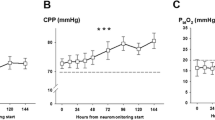Abstract
Because brain edema is correlated with poor outcome in clinical subarachnoid hemorrhage (SAH), appropriate evaluation methods for brain edema are important in experimental SAH studies. Although brain water content (BWC) is widely used to evaluate brain edema in stroke research, the usefulness of brain weight is undetermined. In this study, we examined the role of brain weight in the evaluation of brain edema in experimental SAH. The endovascular perforation model of SAH was used, and rats were assessed by neurological scoring (NS). The brains were quickly removed at 24 h after the operation, and the weights of wet cerebrum (WWC) and dry cerebrum (WDC) were measured to determine the brain water content (BWC). The correlations of those values with each other and to body weight (BW) were then examined to reveal the significance of brain weight. The rats were assigned to sham-operated (n = 8) and SAH (n = 16) groups. There were no significant differences in WWC between the groups (p = 0.61). WWC was correlated with BWC but not with NS in all rats. In addition, WWC was clearly correlated with BW and WDC, which is thought to substitute for the original brain weight. From these results, we suggest that the measurement of brain weight as an evaluation of brain edema is limited and that BW and original brain volume can be confounding factors in evaluation.
Access this chapter
Tax calculation will be finalised at checkout
Purchases are for personal use only
Similar content being viewed by others
References
Ostrowski RP, Colohan AR, Zhang JH (2006) Molecular mechanisms of early brain injury after subarachnoid hemorrhage. Neurol Res 28:399–414
Claassen J, Carhuapoma JR, Kreiter KT, Du EY, Connolly ES, Mayer SA (2002) Global cerebral edema after subarachnoid hemorrhage: frequency, predictors, and impact on outcome. Stroke 33:1225–1232
Xiao F (2002) Bench to bedside: brain edema and cerebral resuscitation: the present and future. Acad Emerg Med 9:933–946
Hasegawa Y, Suzuki H, Altay O, Zhang JH (2011) Preservation of tropomyosin-related kinase B (TrkB) signaling by sodium orthovanadate attenuates early brain injury after subarachnoid hemorrhage in rats. Stroke 42:477–483
Rolland WB, Lekic T, Krafft PR, Hasegawa Y, Altay O, Hartman R, Ostrowski R, Manaenko A, Tang J, Zhang JH (2013) Fingolimod reduces cerebral lymphocyte infiltration in experimental models of rodent intracerebral hemorrhage. Exp Neurol 241:45–55
Uekawa K, Hasegawa Y, Ma M, Nakagawa T, Katayama T, Sueta D, Toyama K, Kataoka K, Koibuchi N, Kawano T, Kuratsu J, Kim-Mitsuyama S (2014) Rosuvastatin ameliorates early brain injury after subarachnoid hemorrhage via suppression of superoxide formation and nuclear factor-kappa B activation in rats. J Stroke Cerebrovasc Dis 23:1429–1439
Fathali N, Ostrowski RP, Hasegawa Y, Lekic T, Tang J, Zhang JH (2013) Splenic immune cells in experimental neonatal hypoxia-ischemia. Transl Stroke Res 4:208–219
Duris K, Manaenko A, Suzuki H, Rolland W, Tang J, Zhang JH (2011) Sampling of CSF via the cisterna magna and blood collection via the heart affects brain water content in a rat SAH model. Transl Stroke Res 2:232–237
Keep RF, Hua Y, Xi G (2012) Brain water content. A misunderstood measurement? Transl Stroke Res 3:263–265
Conflict of Interests
This study was supported by JSPS KAKENHI Grant Number 24592135.
Author information
Authors and Affiliations
Corresponding author
Editor information
Editors and Affiliations
Rights and permissions
Copyright information
© 2016 Springer International Publishing Switzerland
About this chapter
Cite this chapter
Hasegawa, Y. et al. (2016). Assessment of the Correlations Between Brain Weight and Brain Edema in Experimental Subarachnoid Hemorrhage. In: Applegate, R., Chen, G., Feng, H., Zhang, J. (eds) Brain Edema XVI. Acta Neurochirurgica Supplement, vol 121. Springer, Cham. https://doi.org/10.1007/978-3-319-18497-5_15
Download citation
DOI: https://doi.org/10.1007/978-3-319-18497-5_15
Publisher Name: Springer, Cham
Print ISBN: 978-3-319-18496-8
Online ISBN: 978-3-319-18497-5
eBook Packages: MedicineMedicine (R0)




